National Archaeological Museum of Athens - Prehistoric Collection
The New York Times has recently (April 2008) published an article on Athens. In it there is a reference to the National Archaeological Museum of Athens: "In neighboring Exarcheia, the renovated National Archaeological Museum (Patission 44; 30-210-821-7724) has classical sculptures and gold treasures from Mycenae". We think of this reference as being the Understatement of the century! |
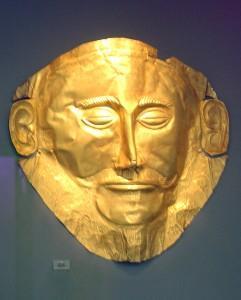 |
Athens National Archaeological Museum:
Exhibit 624. Gold death-mask, known as
the 'mask of Agamemnon'. (Grave V,
Grave Circle A, Mycenae, 16th century BC) |
This is because the Greek National Archaeological Museum in Athens is rightfully considered to be not only the most important, yet also one of the richest archaeological museums in the world in terms of containing Ancient Greek Art! Please refer to the relevant Album as proof of how much right we are!
The Greek National Archaeological Museum is housed in a neoclassical building designed by the noted German architect Ernst Ziller in 1889. It houses perhaps the most impressive collection of ancient Greek treasures in the world. The neoclassical design of the exterior tries its best to keep up with the true Greek classic style of the works it houses. This museum includes the golden so-called "Mask of Agamemnon", excavated by Heinrich Schliemann at ancient Mycenae, the bronze "boy jockey" of Artemision that somehow stayed in great condition despite being fished out of the sea, and a range of excellent sculptures, pottery, furniture and jewellery.
Further wonderful inclusions are:
- Prehistoric items/Ruins
- Sculpture
- Pottery and Minor art
- Bronzes
- Egyptian Art
Operating Hours are as follows:
Monday 13.00-19.30
Tuesday-Sunday 08.30-15.00
Telephone Contact: 210/821-7717 Address: 44, 28th Oktovriou (Patission) Ave, Athens, Greece |
Note: Given the huge number of exhibits, this album on the National Archaeological Museum of Athens is progressing step by step: Please visit this Album from time to time to see it growing!
(Photos: Michael Tziotis)
Select Page of the Album:
- The National Archaeological Museum of Athens: Why this Album?
- The National Archaeological Museum of Athens (The Building)
- Prehistoric Collection / Gallery IV / Mycenaean Civilization / Mycenae
- Gallery IV / Mycenaean Civilization / Mycenae / Grave Circle A / Finds from Graves I, II and VI, 16th century BC
- Gallery IV / Mycenaean Civilization / Mycenae / Grave Circle A / Finds from Grave III, 16th century BC (Window 1)
- Gallery IV / Mycenaean Civilization / Mycenae / Grave Circle A / Finds from Grave III, 16th century BC (Window 2)
- Gallery IV / Mycenaean Civilization / Mycenae / Grave Circle A / Finds from Grave IV, 16th century BC.
- Gallery IV / Mycenaean Civilization / Mycenae / Grave Circle A / Finds from Grave V, 16th century BC.
- Gallery IV / Mycenaean Civilization / Mycenae / Grave Circle A / Jewelry from Graves IV and V, 16th century BC.
- Gallery IV / Mycenaean Civilization / Mycenae / Grave Circle A / Gold and silver tableware from Graves IV and V, 16th century BC.
- Gallery IV / Mycenaean Civilization / Mycenae / Grave Circle A / Pottery vessels, 16th- early 15th century BC.
- Gallery IV / Mycenaean Civilization / Mycenae / Grave Circle A / Ritual vases-rhytons from Graves IV and V, 16th century BC.
- Gallery IV / Mycenaean Civilization / Mycenae / Grave Circle A / Exotic Objects, 16th century BC.
- Gallery IV / Mycenaean Civilization / Mycenae / Grave Circle A / Bronze vessels and tools from Graves III, IV and V, 16th century BC.
- Gallery IV / Mycenaean Civilization / Mycenae / Grave Circle A / Weapons and implements from Grave IV, 16th century BC.
- Gallery IV / Mycenaean Civilization / Mycenae / Grave Circle A / Weapons and implements from Grave V, 16th century BC.
- Gallery IV / Mycenaean Civilization / Mycenae / Grave Circle B / Finds from Graves Alpha, Zeta, Eta and Kappa, 17th-16th cent. BC
- Gallery IV / Mycenaean Civilization / Mycenae / Grave Circle B / Finds from the Male Inhumations in Grave Nu & the Female One in Grave Omicron, 17th-16th cent. BC
- Gallery IV / Mycenaean Civilization / Mycenae / Grave Circle B / Finds from Grave Gamma and Delta, 17th-16th cent. BC
- Gallery IV / Mycenaean Civilization / Mycenae / Grave Circle B / Finds from Graves Beta, Epsilon, Iota, Lamda, Mu, Xi, Upsilon, 16th century BC.
- Gallery IV / Mycenaean Civilization / Mycenae / Bone, Glass and Ivory Artifacts from the Mycenean Acropolis
- Gallery IV / Mycenaean Civilization / Mycenae / Palatial Workshops Finds and Bronze Weapon and Tool Hoards in the Acropolis of Mycenae, 14th-13th centuries BC
- Gallery IV / Mycenaean Civilization / Mycenae / Imported objects and raw materials from abroad, most found on the Mycenae acropolis.
- Gallery IV / Mycenaean Civilization / Mycenae / Clay and stone ritual vessels, used in religious ceremonies (15th-12th century BC).
- Gallery IV / Mycenaean Civilization / Mycenae / Pictorial Style pottery from the Mycenae acropolis.
- Gallery IV / Mycenaean Civilization / Mycenae / Wall-Paintings
- Gallery IV / Mycenaean Civilization / Tiryns/The Tiryns wall-paintings
- Gallery IV / Mycenaean Civilization / Tiryns/The Acropolis of Tiryns
Click on any of the pictures to enlarge.
Gallery IV / Mycenaean Civilization / Mycenae / Clay and stone ritual vessels, used in religious ceremonies (15th-12th century BC). Clay figurines, both human and animal (13th-12th centuries BC), have been discovered in shrines, where they were presented as votive offerings, and in houses and tombs.
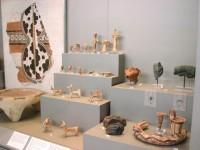
National Archaeological Museum: Clay and stone ritual vessels, used in religious ceremonies (General View of the Window) |
|
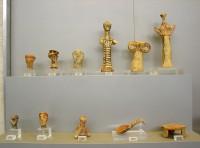
Clay figurines (Two shelves) |
|
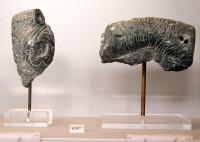
6247. Fragments of Minoan stone chlorite rhytons in the shape of bovine heads with engraved decoration. From the rhyton's well, Mycenae acropolis. 15th century BC |
|
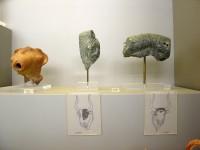
6247, 2914. Fragments of Minoan stone chlorite rhytons in the shape of bovine heads with engraved decoration, 15th century BC and Clay horse's head, from a zoomorphic rhyton, 12th century BC |
|
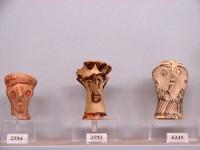
2593, 2594, 6245. Clay female figurines with raised arms (of the so called Psi type) and heads of female figurines and head of a bearded male figurine (6245). |
|
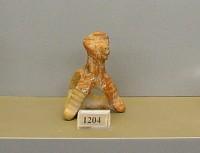
1204. Clay figurine of a seated dog with a hole at the neck (pendant). |
|
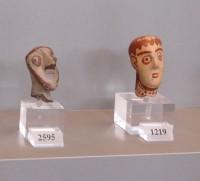
1219, 2595. Heads of female and male figurines |
|
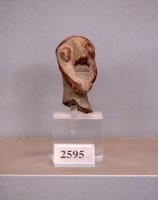
2595. Head of male figurine shown in the previous photo |
|
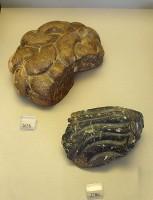
2656. Stone locks, possibly from the hairpiece of a large wooden figurine. |
|
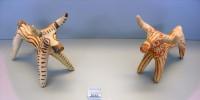
2658. Stylized clay figurines of bulls and possibly a horse. |
|
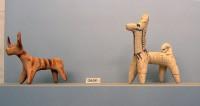
2658. Stylized clay figurines of bulls and possibly a horse. |
|
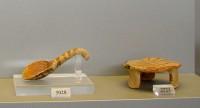
2721, 3028. Clay models of a tripod table and of a small spoon. |
|
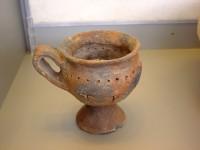
2905. Clay incense burner with pierced body. |
|
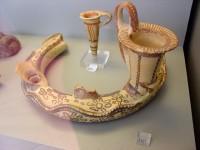
5427. Composite ring shaped ritual vessel (kernos) with a conical rhyton for pouring liquids. 12th century BC
A bovine head adorns the base of the rhyton, while a relief serpentine band and painted rosettes decorate the body. |
|
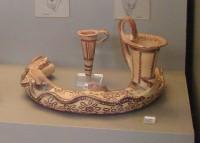
5427. Composite ring shaped ritual vessel (kernos) with a conical rhyton for pouring liquids. 12th century BC |
|
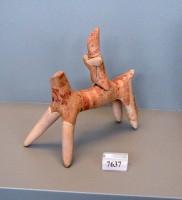
7637. Clay model of a horse and rider. |
|
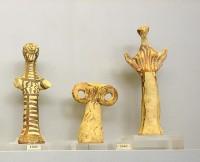
1203, 2661. Clay male figurine with outstretched arms and clay female figurines with raised arms (of the so called Psi type) |
|
|
Select Page of the Album:
- The National Archaeological Museum of Athens: Why this Album?
- The National Archaeological Museum of Athens (The Building)
- Prehistoric Collection / Gallery IV / Mycenaean Civilization / Mycenae
- Gallery IV / Mycenaean Civilization / Mycenae / Grave Circle A / Finds from Graves I, II and VI, 16th century BC
- Gallery IV / Mycenaean Civilization / Mycenae / Grave Circle A / Finds from Grave III, 16th century BC (Window 1)
- Gallery IV / Mycenaean Civilization / Mycenae / Grave Circle A / Finds from Grave III, 16th century BC (Window 2)
- Gallery IV / Mycenaean Civilization / Mycenae / Grave Circle A / Finds from Grave IV, 16th century BC.
- Gallery IV / Mycenaean Civilization / Mycenae / Grave Circle A / Finds from Grave V, 16th century BC.
- Gallery IV / Mycenaean Civilization / Mycenae / Grave Circle A / Jewelry from Graves IV and V, 16th century BC.
- Gallery IV / Mycenaean Civilization / Mycenae / Grave Circle A / Gold and silver tableware from Graves IV and V, 16th century BC.
- Gallery IV / Mycenaean Civilization / Mycenae / Grave Circle A / Pottery vessels, 16th- early 15th century BC.
- Gallery IV / Mycenaean Civilization / Mycenae / Grave Circle A / Ritual vases-rhytons from Graves IV and V, 16th century BC.
- Gallery IV / Mycenaean Civilization / Mycenae / Grave Circle A / Exotic Objects, 16th century BC.
- Gallery IV / Mycenaean Civilization / Mycenae / Grave Circle A / Bronze vessels and tools from Graves III, IV and V, 16th century BC.
- Gallery IV / Mycenaean Civilization / Mycenae / Grave Circle A / Weapons and implements from Grave IV, 16th century BC.
- Gallery IV / Mycenaean Civilization / Mycenae / Grave Circle A / Weapons and implements from Grave V, 16th century BC.
- Gallery IV / Mycenaean Civilization / Mycenae / Grave Circle B / Finds from Graves Alpha, Zeta, Eta and Kappa, 17th-16th cent. BC
- Gallery IV / Mycenaean Civilization / Mycenae / Grave Circle B / Finds from the Male Inhumations in Grave Nu & the Female One in Grave Omicron, 17th-16th cent. BC
- Gallery IV / Mycenaean Civilization / Mycenae / Grave Circle B / Finds from Grave Gamma and Delta, 17th-16th cent. BC
- Gallery IV / Mycenaean Civilization / Mycenae / Grave Circle B / Finds from Graves Beta, Epsilon, Iota, Lamda, Mu, Xi, Upsilon, 16th century BC.
- Gallery IV / Mycenaean Civilization / Mycenae / Bone, Glass and Ivory Artifacts from the Mycenean Acropolis
- Gallery IV / Mycenaean Civilization / Mycenae / Palatial Workshops Finds and Bronze Weapon and Tool Hoards in the Acropolis of Mycenae, 14th-13th centuries BC
- Gallery IV / Mycenaean Civilization / Mycenae / Imported objects and raw materials from abroad, most found on the Mycenae acropolis.
- Gallery IV / Mycenaean Civilization / Mycenae / Clay and stone ritual vessels, used in religious ceremonies (15th-12th century BC).
- Gallery IV / Mycenaean Civilization / Mycenae / Pictorial Style pottery from the Mycenae acropolis.
- Gallery IV / Mycenaean Civilization / Mycenae / Wall-Paintings
- Gallery IV / Mycenaean Civilization / Tiryns/The Tiryns wall-paintings
- Gallery IV / Mycenaean Civilization / Tiryns/The Acropolis of Tiryns
|
|



